Ampol Bundle
Can Ampol Fuel the Future?
Ampol, a cornerstone of Australia's energy sector since 1936, is evolving rapidly. With over 1,800 service stations across Australia and operations in New Zealand, Ampol is more than just a fuel provider; it's a key player in the region's mobility landscape. This Ampol SWOT Analysis offers valuable insights into its strategic direction.
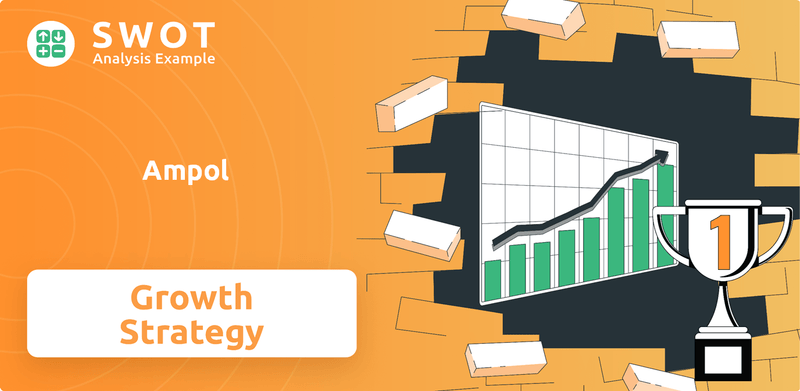
Ampol's recent rebranding and acquisition of Z Energy showcase its commitment to dominating the fuel and convenience markets. This article delves into the Ampol growth strategy, exploring its Ampol future prospects within a changing energy sector. We'll analyze the Ampol company analysis to understand how it's navigating the transition, including its Ampol business model, Ampol market share, and potential Ampol financial performance.
How Is Ampol Expanding Its Reach?
The Ampol growth strategy focuses on strengthening its core business while diversifying into new energy solutions. This involves expanding its convenience retail offer and investing in electric vehicle (EV) charging infrastructure. The company is also exploring opportunities in renewable fuels to adapt to changing market demands and support sustainable practices.
Ampol's future prospects are closely tied to its ability to execute these expansion initiatives effectively. This includes adapting to the evolving energy landscape, managing the transition to EVs, and capitalizing on opportunities in renewable energy. The company's strategic investments and partnerships are key to achieving its long-term goals.
Ampol's commitment to innovation and sustainability positions it well for future growth. By focusing on customer experience, operational efficiency, and strategic partnerships, Ampol aims to maintain its market leadership and create long-term value for its stakeholders.
Ampol is actively growing its Australian convenience retail network, including the construction of new highway sites. They are also piloting premium store designs to enhance customer experiences. In New Zealand, Z Energy, an Ampol subsidiary, plans to refresh 25 retail sites in 2025.
Ampol is trialing rejuvenated food service offers, such as hot kitchens, to expand its offerings. They are also exploring further segmentation of their retail offerings to cater to diverse customer preferences. Z Energy is launching a new digitally based loyalty program in March 2025.
Ampol is expanding its electric vehicle (EV) charging network, with 144 AmpCharge EV charging bays across 59 sites in Australia as of December 31, 2024. Approximately 85 bays are either under construction or awaiting grid connection. While EV uptake has been slower than expected, Ampol remains committed to the rollout.
Ampol is exploring the establishment of a domestic renewable fuels industry in Australia. They are progressing pre-FEED and feasibility assessments with partners like IFM Investors and GrainCorp for a potential renewable fuels refinery at Lytton. This initiative supports hard-to-abate sectors with renewable fuels.
Ampol's expansion strategy encompasses both strengthening its core business and diversifying into new energy solutions. This involves strategic investments in convenience retail, EV charging infrastructure, and renewable fuels. The company is adapting to changing consumer behavior and market dynamics.
- Continued growth of Australian convenience retail, including new highway sites and premium store pilots.
- Expansion of the EV charging network, with adjustments to the pace of investment based on market trends.
- Exploration of renewable fuels, including pre-FEED assessments for a potential refinery.
- Digital transformation through the launch of a new digitally based Z loyalty capability in March 2025.
Ampol SWOT Analysis
- Complete SWOT Breakdown
- Fully Customizable
- Editable in Excel & Word
- Professional Formatting
- Investor-Ready Format
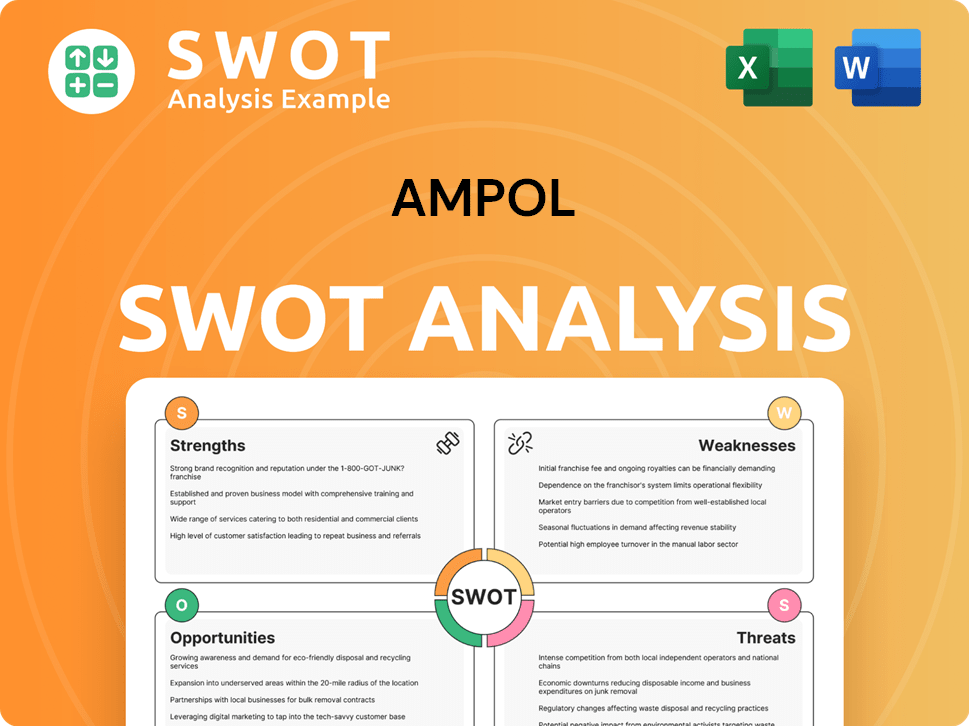
How Does Ampol Invest in Innovation?
The company is actively using technology and innovation to support its growth, especially as the energy sector transitions. This approach is central to its strategy. With a focus on digital transformation, the company aims to enhance customer experience and streamline operations.
The company's digital platform is a key element of its strategy, with the app reaching a significant milestone in 2024. This platform provides exclusive offers, loyalty points, and access to services like EV charging and energy solutions. This digital focus is designed to create a seamless experience for customers.
The company is also investing in its internal technology, digital, and data capabilities. This investment is crucial for supporting its strategic goals. The appointment of Brad Blyth as Executive General Manager, Tech, Digital, and Data in January 2025, highlights this commitment.
The company's digital transformation is a key part of its growth strategy. The app, which reached one million downloads in 2024, offers exclusive deals and access to services. This digital platform is designed to improve customer experience and streamline operations.
The ULSF Project at the Lytton refinery is a major technological undertaking. It is expected to be completed by the end of 2025. This project will enable the refinery to produce ultra-low sulfur gasoline, meeting new Australian fuel standards.
The company is exploring innovations in its retail convenience business. This includes expanding drive-off technology to higher-risk sites. Planned innovation and advancement pilots with this technology are scheduled for 2025.
The company's 2023-2025 Sustainability Strategy emphasizes integrating circular economy principles. This includes using renewable and sustainable raw materials and reusing/recycling equipment. In 2024, the company's Lubricants launched new packaging using 40% recycled post-consumer HDPE.
The ULSF Project is a critical technological upgrade, scheduled for completion towards the end of 2025. This project is essential for producing ultra-low sulfur gasoline, which will meet the new Australian fuel standards that require less than 10ppm sulfur by December 2025. This will also enhance refining margins. Furthermore, the company is exploring innovative solutions for its retail convenience business. This includes expanding the use of drive-off technology to sites with higher risk. The company is planning innovation and advancement pilots with this technology in 2025. These efforts reflect a commitment to both operational efficiency and customer experience. You can learn more about the company's marketing strategies by reading the Marketing Strategy of Ampol.
The company's innovation strategy is multi-faceted, focusing on digital transformation, refining upgrades, and sustainability. These initiatives are designed to improve operational efficiency, enhance customer experience, and meet environmental standards.
- Digital Transformation: The company's app reached one million downloads in 2024, offering exclusive deals and access to services.
- Ultra-Low Sulfur Fuels (ULSF) Project: Completion expected by the end of 2025, enabling the production of ultra-low sulfur gasoline.
- Retail Convenience Innovations: Expansion of drive-off technology and planned pilots in 2025.
- Sustainability: 2023-2025 Sustainability Strategy integrates circular economy principles, including the use of recycled materials. In 2024, the company's Lubricants launched new packaging using 40% recycled post-consumer HDPE.
Ampol PESTLE Analysis
- Covers All 6 PESTLE Categories
- No Research Needed – Save Hours of Work
- Built by Experts, Trusted by Consultants
- Instant Download, Ready to Use
- 100% Editable, Fully Customizable
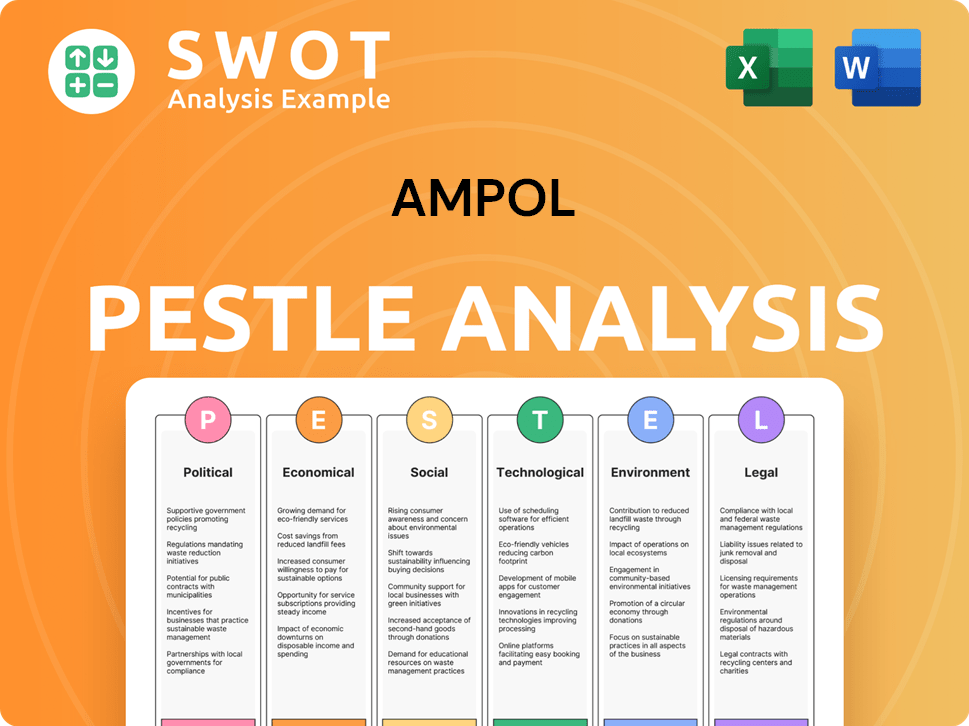
What Is Ampol’s Growth Forecast?
The financial outlook for the company, a major player in the Australian fuel market, is influenced by its strategic initiatives and the wider market conditions. The company's Ampol growth strategy is geared towards navigating the evolving energy landscape and maintaining its market position. The company's financial performance in 2024 reflects both challenges and strategic responses.
For the full year 2024, the company reported a replacement cost operating profit earnings before interest and tax (RCOP EBIT) of $715 million, a 45% decrease from the previous year. RCOP EBITDA was $1.2 billion, down 32% from 2023. Net borrowings increased to $2.77 billion from $2.2 billion in FY23, which was largely due to lower earnings, higher capital expenditure, and prior year dividend payments. The company's leverage rose to 2.6x Adjusted Net Debt/RCOP EBITDA, although management anticipates a return to the target 2.0–2.5x range in 2025 as refinery performance improves.
Despite these financial pressures, the company is focused on disciplined capital allocation and aims to reduce its leverage during 2025. The company declared a final dividend of 5 cents per share, fully franked, bringing total dividends for the 2024 financial year to 65 cents per share. Investment in Energy Solutions peaked in 2024, which means lower capital expenditure is expected ahead. The company is also committed to a $50 million (nominal) cost reduction program for 2025, which includes driving productivity and asset reliability in the supply chain and enhancing the efficiency of technology, digital, and data spending. As of December 31, 2024, the company had a trailing 12-month revenue of $23 billion.
The company's 2024 financial results showed a decline in profitability with RCOP EBIT at $715 million, a 45% decrease. RCOP EBITDA was $1.2 billion, down 32% from the previous year. These figures highlight the challenges faced in the fuel market and the impact of various economic factors. The Ampol market share is also influenced by these financial outcomes.
Net borrowings increased to $2.77 billion, and the leverage ratio rose to 2.6x Adjusted Net Debt/RCOP EBITDA. Management aims to reduce this back to the target range of 2.0–2.5x in 2025. The increase in debt is attributed to lower earnings and higher capital expenditures.
The company declared a final dividend of 5 cents per share, bringing the total dividends for 2024 to 65 cents per share. The company is focused on disciplined capital allocation. Investment in Energy Solutions peaked in 2024, indicating a shift in capital expenditure.
The company has initiated a $50 million (nominal) cost reduction program for 2025. This program aims to improve productivity and asset reliability. The program also focuses on enhancing the efficiency of technology, digital, and data spending.
As of December 31, 2024, the company reported a trailing 12-month revenue of $23 billion. This figure provides a snapshot of the company's overall financial health and its capacity to generate income. This is a key indicator of the Ampol business model's effectiveness.
The company's Ampol future prospects depend on its ability to manage debt, reduce costs, and adapt to changing market conditions. The company's focus on disciplined capital allocation and strategic investments will be crucial. The company's response to changing consumer behavior and its strategies for customer retention will also play a key role.
Ampol Business Model Canvas
- Complete 9-Block Business Model Canvas
- Effortlessly Communicate Your Business Strategy
- Investor-Ready BMC Format
- 100% Editable and Customizable
- Clear and Structured Layout
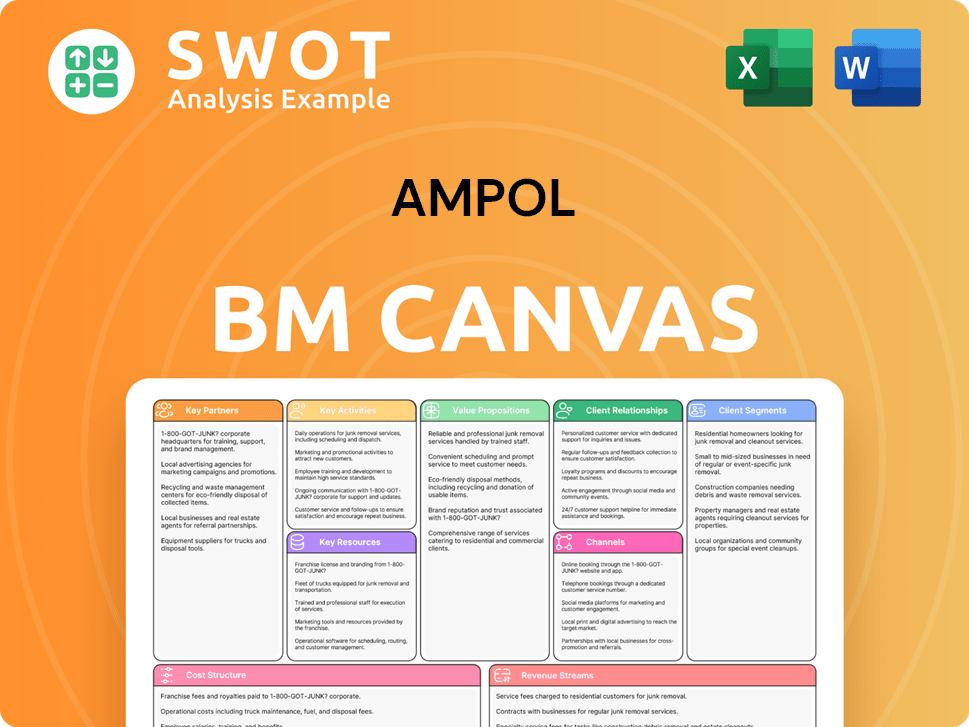
What Risks Could Slow Ampol’s Growth?
The company faces several potential risks and obstacles that could affect its growth and strategic objectives. These challenges range from market competition and changing consumer behavior to operational and technological disruptions. Understanding these risks is crucial for assessing the long-term viability and success of the company's growth strategy.
Market dynamics and the energy transition pose significant hurdles. The company must navigate cost-of-living pressures and adapt to the evolving landscape of the energy sector. This requires strategic investments, operational agility, and a proactive approach to risk management to ensure sustained financial performance.
Operational risks, such as those related to the Lytton refinery, and technological shifts, like the slow adoption of electric vehicles (EVs), highlight the need for robust risk management and strategic foresight. The company's ability to mitigate these risks will significantly influence its future prospects and its ability to maintain its competitive advantage in the fuel market.
The company operates in a highly competitive market. This includes competition from other fuel retailers and evolving energy providers. The company must continually innovate and adapt to maintain its market share and profitability, as discussed in Competitors Landscape of Ampol.
Economic factors, such as rising inflation and living costs, can affect consumer spending on fuel and other products. This can lead to decreased sales volumes and reduced profitability. The company must manage its pricing strategies and operational costs to mitigate these effects.
Operational challenges, such as those at the Lytton refinery, can disrupt production and increase costs. For example, a cyclone in March 2025 led to approximately 10 days of lost production and an estimated $20 million in repair costs, plus $5 million per month in increased demurrage costs for three months. These events can significantly impact financial performance.
The shift towards electric vehicles (EVs) and renewable energy sources poses a significant challenge. While the company is investing in EV charging infrastructure, the uptake of EVs has been slower than anticipated. The company aimed for 300 fast-charging bays by the end of 2024 but delivered only 144 across 59 sites in Australia by December 31, 2024. This requires careful planning and investment in new technologies.
Regulatory changes, such as new Australian fuel standards mandating ultra-low sulfur fuels by December 2025, require significant investment in refinery upgrades. These investments can strain financial resources and affect profitability. The company must comply with these regulations to maintain its operations.
Managing the complexities of the supply chain is crucial for ensuring efficient operations and cost management. Disruptions or inefficiencies in the supply chain can lead to increased costs and reduced profitability. The company must continually optimize its supply chain to mitigate these risks.
The company uses a comprehensive risk management framework based on the International Standard for Risk Management (ISO 31000). This systematic approach helps identify, assess, treat, and monitor risks that could impact business objectives. The Board oversees this framework to ensure effective risk management.
The company emphasizes continuous improvement in safety and environmental performance through initiatives like significant investment in contractor safety training and a Security Risk Framework program across its sites. These initiatives aim to mitigate operational risks and enhance overall performance.
Ampol Porter's Five Forces Analysis
- Covers All 5 Competitive Forces in Detail
- Structured for Consultants, Students, and Founders
- 100% Editable in Microsoft Word & Excel
- Instant Digital Download – Use Immediately
- Compatible with Mac & PC – Fully Unlocked
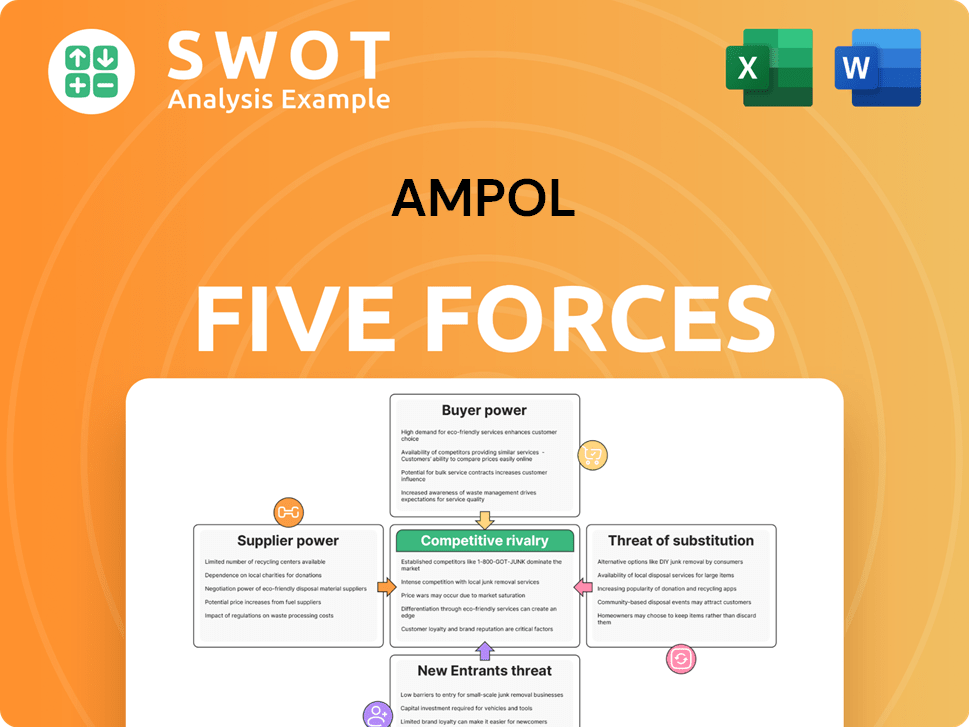
Related Blogs
- What are Mission Vision & Core Values of Ampol Company?
- What is Competitive Landscape of Ampol Company?
- How Does Ampol Company Work?
- What is Sales and Marketing Strategy of Ampol Company?
- What is Brief History of Ampol Company?
- Who Owns Ampol Company?
- What is Customer Demographics and Target Market of Ampol Company?
Disclaimer
All information, articles, and product details provided on this website are for general informational and educational purposes only. We do not claim any ownership over, nor do we intend to infringe upon, any trademarks, copyrights, logos, brand names, or other intellectual property mentioned or depicted on this site. Such intellectual property remains the property of its respective owners, and any references here are made solely for identification or informational purposes, without implying any affiliation, endorsement, or partnership.
We make no representations or warranties, express or implied, regarding the accuracy, completeness, or suitability of any content or products presented. Nothing on this website should be construed as legal, tax, investment, financial, medical, or other professional advice. In addition, no part of this site—including articles or product references—constitutes a solicitation, recommendation, endorsement, advertisement, or offer to buy or sell any securities, franchises, or other financial instruments, particularly in jurisdictions where such activity would be unlawful.
All content is of a general nature and may not address the specific circumstances of any individual or entity. It is not a substitute for professional advice or services. Any actions you take based on the information provided here are strictly at your own risk. You accept full responsibility for any decisions or outcomes arising from your use of this website and agree to release us from any liability in connection with your use of, or reliance upon, the content or products found herein.